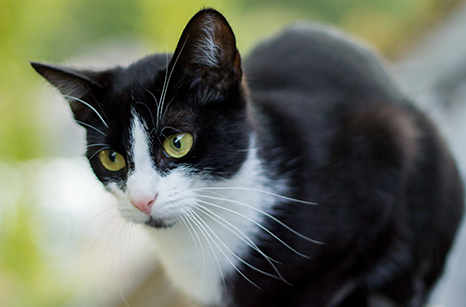
Congratulations on deciding to have your cat spayed. Spaying is the common term used to describe the surgical procedure known scientifically as an ovariohysterectomy. The benefits to your pets health and helping to reduce the pet overpopulation crisis makes this decision easier.
Spaying is very beneficial to the health of the cat, especially if performed at an early age. Here are several health benefits associated with spaying your cat:
Spaying eliminates the risk of ovarian cancer and uterine cancers. Breast cancer is the number one type of cancer in intact or unspayed female cats. If your cat is spayed before her first heat cycle, there is less than 1/2 to 1 % chance of developing breast cancer. With every subsequent heat cycle, the risk of developing breast cancer increases. After 2 1/2 years of age, an ovariohysterectomy gives no protective benefit against developing breast cancer.
Pets with diabetes or epilepsy should be spayed to prevent hormonal changes that may interfere with medications.
The most obvious benefit is the prevention of unplanned pregnancies.There is no medical or scientific reason for letting your cat have a litter before she is spayed.
Once a cat reaches puberty, usually around seven months of age, she will have a heat or estrus cycle every 2 to 3 weeks for most of the year, unless she becomes pregnant. She will be “in heat” or receptive to mating for approximately one week in each cycle. During “heat” she may displayunsociable behavior such as loud and persistent crying and frequent rubbing and rolling on the floor. This behaviour coupled with her scent, will attract male cats from miles around. Removal of her ovaries will stop her estrus cycles.
Spaying should be performed before the first estrus or “heat cycle”. Most cats are spayed around6 months of age. It is possible to spay your cat if she is pregnant.
A cat spay is considered a major surgical procedure that requires a full general anaesthetic. When your cat is admitted for surgery, she will be examined by the veterinarian performing the surgery, and pre-anaesthetic blood tests will be performed if you have chosen to do so. We also recommendintravenous fluids be given during and after surgery to provide a more stable anaethesia and quicker recovery. After your pet is anaesthetized, a breathing tube will be placed in her trachea or windpipe.This will allow the delivery of oxygen and the gas anaesthetic directly into the lungs. The operation is performed through a relatively small incision made most commonly in the midline of the abdomen, just below the umbilicus. Both ovaries are removed along with the entire uterus. The surgical incision will be closed with several layers of sutures. In many cases, skin sutures will be placed, and these will be removed in 7 to 10 days if the traditional method of surgery was used, and in 14 days if the laser was used. Laser Therapy is performed on the incision post-operatively.
In general, complications are rare during the spaying of cats. With modern anaesthetics and monitoring equipment, the risk is very low. However, as with all surgical procedures, there is always a small risk:
- Anaesthetic Complication– It is always possible that any pet could have an adverse reaction following the administration of any drug. Such cases are impossible to predict, but fortunately are extremely rare. Pre-operative bloodwork is a useful screening test that may detect pre-existing problems which could interfere with the pets ability to handle anaesthetic drugs.
It is important that you properly fast your cat prior to surgery according to our instructions. In addition, any signs of illness or previous medical history should be reported to us prior to any sedation, anaesthesia or surgery.
- Internal Bleeding– This can occur if a ligature around a blood vessel breaks or slips off after the abdomen has been closed. This is very rare, and is more likely to occur if the cat is extremely active. Clinical signs include weakness, pale gums, depression, anorexia, or a distended
- This is a true emergency. Please call us immediately!
Post Operative Infection– This may occur internally or around the incision wound. In most cases the infection can be controlled with antibiotics. This most commonly occurs when the cat licks the site excessively or is in a damp environment.
In the vast majority of cases, there are absolutely no adverse affects following spaying. In certain cats, notably the Siamese breed, the hair that grows back over an operation site may be noticeably darker, believed to be due to a difference in the skin temperature. This darker patch may grow out with the following molt as the hair is naturally replaced.
There are many myths and rumors about spaying that are not supported by facts or research. Be sure to address any questions or concerns you may have with your veterinarian prior to surgery.
Cat Spay Package
BENEFITS TO IV FLUIDS FOR ANAESTHESIA & SURGERY
- Intravenous fluids help to maintain normal blood pressure under anaesthesia.
- Intravenous fluids provide venous access in emergency situations and help keep the organs perfused.
- Intravenous fluids result in a more stable anaesthesia, and a quicker recovery for our patients.
BENEFITS TO POST OPERATIVE LASER THERAPY
Laser Therapy reduces pain and inflammation, stimulates nerve regeneration, muscle relaxation and immune system response. This significantly reduces healing time.
WHY LASER SURGERY?
- LESS PAIN – Laser energy seals nerve endings as it moves through tissue. Your pet feels less pain post-operatively.
- LESS BLEEDING – The laser seals small blood vessels during surgery which allows us to perform surgeries with extraordinary precision. This also speeds some procedures reducing the amount of anesthesia needed.
- LESS SWELLING – Laser energy does not crush, tear or bruise because only a beam of intense light contacts the tissue.


